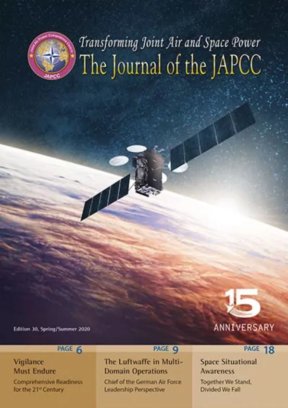Introduction
NATO’s military alliance consists of 30 independent countries. For several reasons they have many different types of military aircraft, but in some cases there are multiple nations operating the same aircraft type. For the alliance to use those aircraft in a comparable way, agreements are required to make it possible to achieve similar flexibility. Aircraft Cross-Servicing (ACS), as a military procedure within the Air Force and as an agreement between nations, enables Nations to have their manned aircraft serviced at NATO airfields outside their own territory. The Aircraft Cross-Servicing Programme (ACSP) in NATO has been dormant since 2007. After a request for support1 to reactivate the programme, HQ AIRCOM supported by the Joint Air Power Competence Centre (JAPCC) re-designed the programme and reviewed all relevant documents. The programme has been reactivated as of December 2018.
Historical Background
In 1952, only a few years after the founding of NATO, the servicing of NATO aircraft outside their own territories was discussed. The result was a document that outlined missions based on both Article 5 and non-Article 5 missions, of the North Atlantic Treaty.2 To meet the requirements of international support, national and multinational structures of NATO were required to allow operational commanders to launch tactical aircraft away from their main-operating bases, using personnel and equipment from other nations. To achieve this, the Headquarters Allied Air Forces Central Europe (AAFCE) established a working group to study the standardization of cross-servicing of tactical aircraft within continental Europe. The working group was technically directed by the Supreme Headquarters Allied Powers Europe (SHAPE).3 This was a result of previous exercises, identifying that standardization had to be done to get a good working programme.4 In 1954 however, the implementation of the ACSP seemed unrewarding and nations favoured bilateral agreements.5 Regardless of the fact that many nations preferred bilateral agreements, the first Standardization Agreement (STANAG) was ratified in the 1960s.
In the following years, the need for cross-servicing of member states and institutional actors was repeatedly raised, resulting in the improvement of the STANAG.6 In 2007, due to a change in the NATO Command Structure and a lack of requirements, the ACSP entered a dormant stage. However, some nations continued and successfully developed the ACSP on the basis of bilateral agreements. Germany, currently offering the largest range of services for a wide variety of visiting aircraft, stood out in particular.
In recent years, NATO and the JAPCC worked on the reactivation of ACSP and revised, simplified and adapted the complete standardization. The European Air Group (EAG) has also recognized the necessity of ACS and joined the two parties to continuously develop the programme.7 The new STANAG 3430 has now been reactivated by NATO and constitutes the agreement on the implementation of several ACSP documents.
Why is Aircraft Cross-Servicing Important?
The Allied Aircraft Cross-Servicing Publication-13 (AASSEP-13) describes the aim of the ACSP as follows: ‘The primary intent of the Aircraft Cross-Servicing (ACS) Programme is to be a force enabler for operational commanders by proving flexible and affordable means of achieving rapid regeneration of available manned aircraft. The secondary aim is to provide a solution for reducing the logistic footprint and to maximize interoperability.’8
One of the challenges of increasing the possible operational area of a military aircraft is the limited availability of Air-to-Air Refuelling (AAR). AAR enables an aircraft to fly longer distances without a stopover, but it is associated with immense costs and therefore only a limited alternative. Increasing the amount of AAR could subsequently reduce the need for ACS in some areas. However, this programme will also enable commanders to respond quickly, by increasing the flexibility and mobility of deployed air forces.9 Further challenges are the transfer of air forces and their rotation, the rapid deployment into a possible defence scenario and the evasion to other airfields. ACS could be one of the programmes to increase resilience.
In addition, there are technical aspects which need to be considered and which require an ACSP. In accordance with the current regulation, a flight service inspection must be carried out before, between and after a flight. The aim is the early detection of faults, replenishing resources and applying aircraft configuration changes. Furthermore, a flight service inspection only has a limited validity, which means that after a certain period of time a full inspection by a licensed mechanic must take place. The ACSP does not replace a full inspection by specially trained and licensed mechanics, but it allows operation of aircraft outside the host nation within certain limits and thus satisfying the safety and airworthiness aspects.
The pilots are also well-trained to carry out flight-service inspections on their aircraft if required. However, they are not sufficiently technically trained, as this is not their normal job. Also, the performance of such an activity would place an additional burden on the pilot and also restrict their possible flight service and rest periods during peacetime flight operations. In addition to these routine activities, which are necessary for flight operations, the pilot, especially for fighter aircraft, needs further support in supplementing ammunition and weapons.
The process for a flight which requires a stopover in a foreign country should be supported by trained personnel. NATO, together with its partners, has military airfields in almost every area of NATO territory where aircraft technical personnel are available. Therefore, it is essential to train personnel about the aircraft of their NATO partners. Like that, these personnel can be employed to reach the alliance’s goal of cross-servicing within NATO according to STANAG 3430.
The Aircraft Cross-Servicing Programme
The agreement of all participating nations to the ACSP is recorded in the already mentioned STANAG 3430. It consists of the Allied Command Operations (ACO) Directive 80-53, the new Allied Aircraft Cross-Servicing Publication-13 (AASSEP-13) and subdivided special regulations such as aircraft-specific instructions, ground handling, equipment and training.10
The responsibilities for the new ACSP are described in the ACO Directive 80-53. The strategic management is being carried out by SHAPE and the management of the ACSP is done by AIRCOM. In addition, every single NATO nation has an executive responsibility. Any nation can assume the role of the sending or receiving nation. A sending nation needs support for its aircraft while the receiving nation supports a visiting aircraft.
In the new ACSP, the programme description, requirements, implementation and validation have been fundamentally revised and separated from the old agreement, the Allied Command Europe (ACE) Directive 80-53. In addition, duplications from other STANAGs were filtered, transferred and summarized in the AASSEP-13.
The New Aircraft Cross-Servicing Programme
The new ACSP was developed out of the preceded programme. To be able to carry out all the necessary work on the aircraft, the programme includes more than technical work on the aircraft. It also covers operational tasks such as debriefing, re-tasking and mission planning.
There are different levels representing the required and permitted range of services on aircraft. In the former ACSP, the service levels were divided into three stages: STAGE A, STAGE B and STAGE C. The new programme is dividing the service levels into two main areas, Basic Cross-Servicing and Mission Cross-Servicing. Mission Cross-Servicing, although referred to some parts of this standard, is not completely defined as it is going through a full revision.
Basic Cross-Servicing is similar to the former STAGE C and includes work that can be supervised by the aircrew. These contain refuelling, marshalling, ground handling, replenishment of fluids and gases (like Oxygen), starting of the engine and removal of safety devices of the weapons system. This level also covers optional capabilities which were previously written in STAGE A.
Mission Cross-Servicing includes the work of Basic Cross-Servicing and also covers the capabilities for mission planning and weapon loading. This function, formerly known as STAGE B, is currently inactive and awaiting a full revision as mentioned before.
Each participating nation, the sending nation and the receiving nation, is responsible for providing the training necessary to maintain this capability. As a result, exercises will be carried out at regular intervals to evaluate the capabilities and to further develop the programme.11
Challenges
Most nations contracted their own country’s industry to manufacture ground equipment and materials to maintain their aircraft. Unfortunately, this is often only adapted to one aircraft type and is not always according to the NATO standard. Therefore, it cannot be used on every NATO aircraft. This resulted in the manufacturing of applicable adapters, to carry out equipment supplements. NATO recognized this problem as early as 1952 and commissioned each nation to provide suitable adapters.12 However, due to the diversity of aircraft, suitable material is still not available everywhere.
A new challenge for the ACSP is that some nations like Hungary and the Czech Republic do not own their military aircraft (Saab JAS 39 ‘Gripen’). They lease them from the non-NATO nation Sweden.13 In some cases these contracts require that only personnel from their own country may work on the aircraft, which severely restricts the ACSP. The officer responsible for the ACSP at HQ AIRCOM said ‘There are ongoing talks with the aircraft owner and manufacturer to formalize the ways to allow Basic Cross-Servicing. It is expected to be feasible to do it.’14
The implementation of cross-servicing of 5th generation aircraft is another challenge. Several NATO nations are replacing their 4th generation aircraft with F-35s (USA, ITA, GBR, NOR, NLD, DNK, BEL). The maintenance of 5th generation aircraft faces additional challenges, mainly related to the security aspects of the platform and its systems. Some owner nations are addressing these challenges with the appropriate entities, assuming these challenges might be solved in the (near) future.
A solution to the challenge posed by the European NATO members could be the full implementation of the European Military Airworthiness Requirements (EMAR) regulation. Since 2008, the European Military Airworthiness Authority has been developing this regulation to harmonize the standardization of military aircraft, materials and personnel.15 The newer European aircraft types, like the Airbus A400M, are already EMAR certified. The certification process for existing aircraft however, would take a long time. This would not be a satisfactory for short- to medium-term solutions, nor is it applicable to other nations outside Europe, such as the United States and Canada. Although in the long-term they might sign up voluntarily to comply with EMAR.
It is questionable whether NATO will ever get to Mission Cross-Servicing. As already mentioned, NATO’s plan also includes the ability to carry out this stage of service. However, the financial and personnel involvement of nations in Basic Cross-Servicing is already limited, making the expansion to Mission Cross-Servicing unrealistic at present. In addition, national regulations regarding the requirements for obtaining and maintaining the qualification of ground personnel and thus airworthiness are currently not flexible enough to meet the requirements. The SME of Logistics of the JAPCC names a possible solution to this problem: ‘One solution might be to form multinational, forward deployable teams ready to administer aircraft servicing on very few Strategic Bases, selected through dynamic planning according to the potential threat or counter-attack mission. The deployment of a multinational team could also solve the security problems of the 5th generation aircraft, which are solved by special licensed personnel.’16
Conclusion
The Aircraft Cross-Servicing Programme is a necessary and, above all, suitable procedure to increase the flexibility and expand aircraft range limitations in the future. There are many and various challenges in implementing this NATO-wide programme. This has already been demonstrated by the fluctuating development spanning 70 years, which has still not reached its final goal. The need for a common defence policy legitimizes further the ongoing work on ACS and, with the new ACSP, will definitely lead to more frequent ACS between nations and allow NATO Air Forces to work closely together again.












